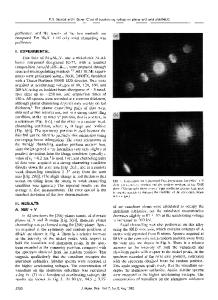Deformation Twinning in Ordered Intermetallic Compounds
- PDF / 486,826 Bytes
- 8 Pages / 420.48 x 639 pts Page_size
- 96 Downloads / 563 Views
DEFORMATION TWINNING IN ORDERED INTERMETALLIC COMPOUNDS* M. H. YOO, C. L. FU, AND J. K. LEEt Metals and Ceramics Division, Oak Ridge National Laboratory, Oak Ridge, TN 37831-6115 ABSTRACT Mechanistic understanding of deformation twinning in ordered superlattice structures is reviewed, and the inter-relationships between twinning and generalized plastic flow or fracture toughness are discussed. While general discussions refer to all the fcc-based and bcc-based cubic and noncubic ordered intermetallic alloys, specific calculations of the energetic and kinetic aspects of deformation twinning are made for TiAl. The importance of the twin-slip conjugate relationship on high temperature mechanical properties is emphasized. Discussion is given of possible effects of macro- and micro-alloying on twinning propensity. INTRODUCTION As one of the two principal modes of plastic deformation in crystalline solids, deformation twinning is generally known to play a significant role in mechanical behavior at high strain rates and/or low temperatures. In ordered intermetallic alloys, however, deformation twinning makes many important contributions to mechanical properties even at high temperatures [1-5]. The awareness of the importance of deformation twinning in the plastic deformation of ordered intermetallics has been growing recently, particularly in the L10 type [6-9] and DO22 type [10-15] tetragonal crystal structures. For instance, several papers in these proceedings discuss deformation twinning in TiAl and related ternary alloys [16-19]. The crystallography of twinning in fcc- and bcc-based superlattice structures, of both cubic and noncubic symmetry, has been reviewed by Christian and Laughlan [3]. This review includes an extensive discussion of the "true" twinning and "pseudo" twinning. In a recent paper [5], we
identified the conjugate relationship between the complementary twinning and the active slip systems at elevated temperatures and discussed their implications on the strength and ductility of ordered intermetallic alloys.
The purpose of this paper is to establish the foundation for the mechanistic understanding of deformation twinning in ordered intermetallic compounds. Following a brief review of the crystallography of twinning in the L10 structure, the energetic and kinetic aspects of twin formation are analyzed by making specific calculations for TiAl. Discussion is then given of the role deformation twinning plays in crack-tip plasticity of ordered intermetallic alloys. CRYSTALLOGRAPHY The three possible modes of twinning in the L10 structure are described in Fig. 1. The crystallographic elements, K1, K2, i1, T12, and S, and parameters q and g are listed in Table I. The twinning shear is g = 2 cos V, where V is the acute angle between 111and 112, and the magnitude of shear is given in Table 1 in terms of the axial ratio, X = c/a. The K1 lattice planes are intersected by 112 an integral number, q, of times, and similarly -4- is the number of K2 planes intersected by il1. When q or -•-is greater than 2, some atom
Data Loading...











